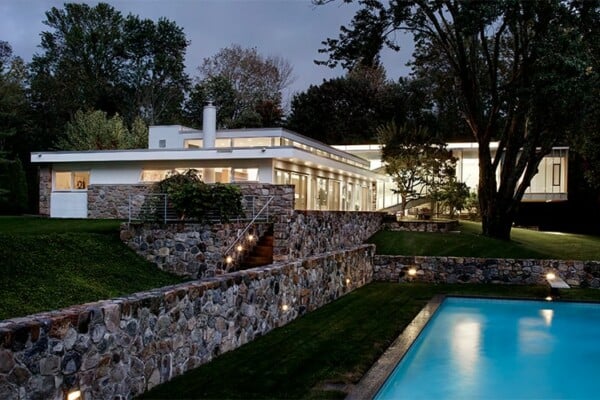142 Kenilworth is a contemporary home located in Toronto, Canada.
It was designed by Johnson Chou.
142 Kenilworth by Johnson Chou:
“Located in the Beaches neighbourhood in Toronto’s East End, the original structure was a two-storey 1,250 SF (139m2) building renovated into a three-storey 1,950 SF (178m2) residence achieved by converting the existing attic space into a master bedroom with ensuite and adding a two-storey rear extension. Built in the early 1900’s, maintaining the integrity of the scale and form of the building, such as retaining the roofline and preserving, repairing the existing brick, was a priority from the start.
Yet there was a desire to allow elements of the modernist aesthetic developed for the interior to percolate to the exterior. As the building is one of a series of nearly identical houses with similar details mirrored along the street, an opportunity arose to insert abstracted elements that juxtaposed and created a dialogue with the existing façades.
The original 3 bedroom house had the main stair positioned perpendicular to the length of the house, effectively dividing the house into two – front and rear. Further exacerbated by the profusion of tiny rooms and the relatively narrow width of the building, the house felt cramped and imparted a sense of claustrophobia. Our functional strategy was to demolish the interior of the existing building, eliminate all interior partitions on the ground floor; reposition the main stair parallel and against the side wall of the building; remove the exterior wall facing the backyard and replace it with a 15’ (4.5 m) deep 200 SF (23m2) two-storey addition.
The intention is to have the two levels of the existing interior spaces overlook the double-height space of the newly created living-room, with it becoming the visual link and the notional “hub” of the residence. The design concept was two-fold: to perforate the volume of the building with openings to allow internal and long views directly to the exterior, creating the impression of a larger building; to develop a motif that redefines the existing building as a series of overlapping “frames” that function either as portals or an apparatus for viewing.
As such the project is about creating volumes of flowing spaces in the horizontal and vertical dimensions, and the kinaesthetic experience of framed views from within and without. The frame motif can be perceived, for example, at the front entrance screen, the main circulation stair and the rear glass façade.
From the entrance one has a view over the family room and past the kitchen, dining and living rooms. Here, the solidity evoked by the front façade dematerializes to a veneer of glass where narrow, custom-fabricated mullions frame the aperture to create the illusion of being detached from the house – a window hovering in mid-air. An oversized pivoting glass door leading to the outdoor patio blurs the distinction between the interior and exterior spaces.
The attic was transformed into the master bedroom and ensuite which are separated by frameless glass screens. The ceiling was flattened but the pitched-roof was maintained at the front to blend in with the adjacent buildings. The triangular-shaped attic window frames the freestanding tub, allowing for an uninterrupted view to the park beyond.”
Photos courtesy of Johnson Chou





















































very attractive